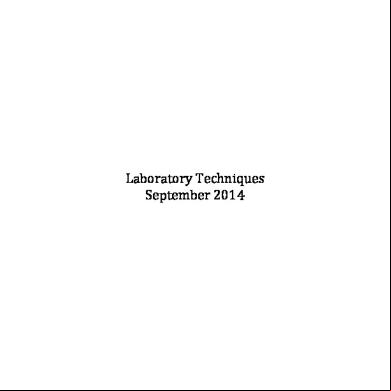Laboratory 01 - Curvilinear-squares 2xd3s
This document was ed by and they confirmed that they have the permission to share it. If you are author or own the copyright of this book, please report to us by using this report form. Report 3b7i
Overview 3e4r5l
& View Laboratory 01 - Curvilinear-squares as PDF for free.
More details w3441
- Words: 350
- Pages: 2
UNIVERSITY OF BOTSWANA DEPARTMENT OF ELECTRICAL ENGINEERING EEB327 ELECTROMAGNETIC FIELDS THEORY FIELD PLOTTING – CURVILINEAR-SQUARES
Aim The experiment uses a graphical field plotting technique to plot an E and D field for a given configuration of conductor boundaries. Equipment Pencil, eraser, and paper. Procedure 1.
Field Plotting Introduction The theory regarding curvilinear field plotting is given in the fifth edition of the book entitled Engineering Electromagnetics by William H. Hayt, Jr. on pages 162 to 168. The first part of the experiment involves the field plotting for a two conductor boundary configuration given in Figure 1. In this figure the equipotential lines have been drawn with a constant potential difference between the lines. Draw in flux lines keeping in mind that these lines leave, cross equipotential lines, and terminate on conductors at right angles. Further lines can be drawn in obeying a single rule that the intersection with equipotential lines must be square. See above reference [page 163 to 164) for more details.
2.
Field Plotting Exercises Figure 2 shows a cross-section of two circular cylinders at potentials of 0 and 60 volts. The axes are parallel and the region between the cylinders is air-filled. Equipotentials at 20 V and 40 V are also shown. Prepare a curvilinear-square map on the figure and use it to establish suitable value for: a) the capacitance per meter length; b) E at the left side of the 60 V conductor if its true radius is 2 mm; c) ρs at that point. Construct a curvilinear-square map for a coaxial capacitor of 2.5 cm inner radius and 8 cm outer radius. These dimensions are suitable for the drawing. As a check on the accuracy, compute the capacitance per meter length both from your drawing and from the exact formula for εr = 1.
Results and Conclusion From the above observations write a paper (word processed), on the field plotting using curvilinearsquares. Your paper should include a discussion on the implications of the observations. Your paper should include an Abstract, Introduction, Results and Discussion, Conclusion, and a Reference section.
1
Figure 1
Figure 2
2
Aim The experiment uses a graphical field plotting technique to plot an E and D field for a given configuration of conductor boundaries. Equipment Pencil, eraser, and paper. Procedure 1.
Field Plotting Introduction The theory regarding curvilinear field plotting is given in the fifth edition of the book entitled Engineering Electromagnetics by William H. Hayt, Jr. on pages 162 to 168. The first part of the experiment involves the field plotting for a two conductor boundary configuration given in Figure 1. In this figure the equipotential lines have been drawn with a constant potential difference between the lines. Draw in flux lines keeping in mind that these lines leave, cross equipotential lines, and terminate on conductors at right angles. Further lines can be drawn in obeying a single rule that the intersection with equipotential lines must be square. See above reference [page 163 to 164) for more details.
2.
Field Plotting Exercises Figure 2 shows a cross-section of two circular cylinders at potentials of 0 and 60 volts. The axes are parallel and the region between the cylinders is air-filled. Equipotentials at 20 V and 40 V are also shown. Prepare a curvilinear-square map on the figure and use it to establish suitable value for: a) the capacitance per meter length; b) E at the left side of the 60 V conductor if its true radius is 2 mm; c) ρs at that point. Construct a curvilinear-square map for a coaxial capacitor of 2.5 cm inner radius and 8 cm outer radius. These dimensions are suitable for the drawing. As a check on the accuracy, compute the capacitance per meter length both from your drawing and from the exact formula for εr = 1.
Results and Conclusion From the above observations write a paper (word processed), on the field plotting using curvilinearsquares. Your paper should include a discussion on the implications of the observations. Your paper should include an Abstract, Introduction, Results and Discussion, Conclusion, and a Reference section.
1
Figure 1
Figure 2
2





